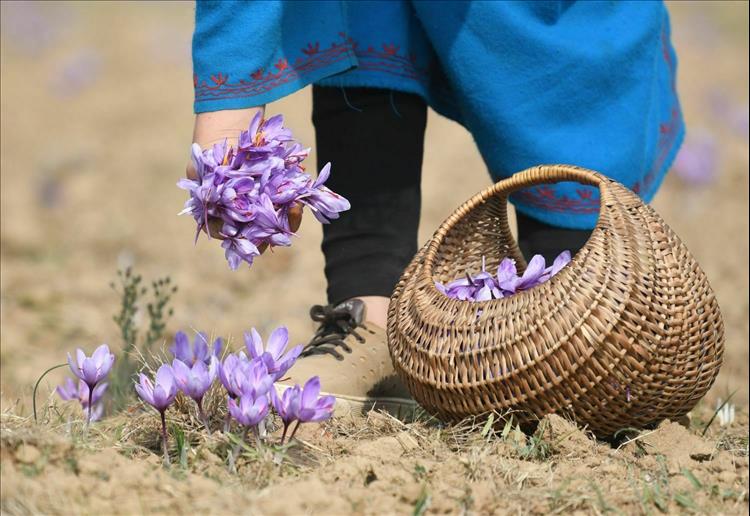(MENAFN- Kashmir Observer) Pampore- The dry spell in Kashmir has had a devastating impact on saffron production this year, with yields dropping by 50 to 70 percent compared to previous years. Saffron growers from the Pampore area of south Kashmir's Pulwama district have raised concerns about the situation, citing inadequate rainfall and prolonged dry conditions as the main factors affecting the crop's growth.
According to saffron growers, including prominent figures like Abdul Hamid from Pulwama and Mohammad Ashiq from Lethpora, the limited rainfall this autumn, particularly a light rain in September, has been insufficient to support healthy saffron cultivation.
ADVERTISEMENT
“The lack of proper rainfall during critical months has affected not just saffron, but most crops in the region this year,” Hamid said. He expressed concerns that the crop's production is expected to be less than half of what it was in previous years.
ADVERTISEMENT
Ashiq, another local grower, lamented that the dry weather had not only reduced saffron production but also raised the costs of cultivating the crop.“The expenses on saffron cultivation this year are far greater than what we will likely earn from the harvest,” he said, adding that the situation is pushing many farmers to the brink. He criticised the National Saffron Mission (NSM), which was launched in 2010 with the aim of revitalising saffron cultivation in the region, accusing it of failing to achieve its objectives.
“The NSM has been a failure. Every time we raise our concerns about its ineffectiveness, those same departments that have failed to deliver are made part of the investigation committees,” Ashiq said. He and other saffron growers are now demanding an independent investigation into the matter so that officials and departments responsible for the neglect can be held accountable.
Read Also
Red Gold Feat: Inspired By Kashmir, Man Grows Saffron In His Indore House
Video: Pampore Municipality Chooses Saffron Field For Dumping Garbage
Abdul Majeed Wani, President of the Saffron Growers Association of Kashmir, said this year's production has decreased by at least 50 percent compared to last year.“This dry spell has hit us hard, and the decrease in production is a direct result of this prolonged drought. Without urgent action, the future of saffron cultivation here is in jeopardy,” he said.
Other growers from Pampore and surrounding areas also reported reduced yields. The impact of climate change, coupled with the failure of irrigation systems and inadequate support from the government, has left many saffron farmers in dire straits.
According to data obtained, saffron production in Jammu and Kashmir has been on a consistent decline over the years. From 8.0 metric tons (MT) in 2010-11, production fell to just 2.6 MT in 2023-24, marking a drastic 67.5% decrease. While there was a slight recovery in production last year (2022-23), with a marginal 4% increase, it remains far below the figures seen a decade ago.
In 2013-14, saffron production in the region peaked at 14.01 MT with a yield of 3.82 quintals per hectare. However, production has since fluctuated, with significant declines in the years that followed. In 2019-20, production plummeted to a mere 0.02 MT, with a yield of just 4.44 quintals per hectare. The production figures remained stagnant in subsequent years, with no significant recovery.
The National Saffron Mission has come under heavy scrutiny by local farmers. Although the NSM included measures like the installation of borewells for irrigation, there are reports suggesting that many of these borewells are either non-functional or not being properly maintained.
According to agricultural department officials, out of the 110 borewells under the NSM, only 77 are currently operational. However, they also said that farmers are not taking ownership of the wells, which may contribute to the lack of effective utilization.
Despite the claim by officials that some improvements have been made, the overwhelming majority of saffron growers feel that the assistance provided under the NSM has been inadequate. This has further fuelled calls for an independent investigation into the mission's efficacy.
The ongoing crisis has serious implications not only for the saffron growers but also for the regional economy. Saffron, often referred to as the“golden spice”, is an integral part of Kashmir's agricultural heritage, and its decline threatens the livelihoods of thousands of farmers who depend on it for their income. Kashmir saffron holds a unique place in global markets due to its high quality, and its diminishing production could harm the region's standing in the international trade of this prized commodity
Follow this link to join our WhatsApp group : Join Now























Comments
No comment